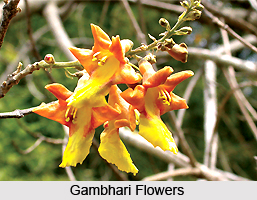 Gambhari is medium sized deciduous tree which is found mainly in the deciduous forests throughout India. Its Botanical name is Gmelina arborea Roxb. Various other names by which it is called in India are Gamari, Gumbar and Gumar in Bengali, Gambhar, Kamhar, Gumhar, Khamer, Kumher, Khambari and Sewan in Hindi, Niuvon and Sovony in Konkani, Gamar, Sewan, Kamar and Shewan in Marathi, Ban, Kumhar and Gumhar in Punjabi, Gumadi, Kumadi, Pemngumpil, Kattanam, Umi-thekku and Umi in Tamil, Savan, Shewan, Sivan and Shivan in Gujarati, Bachanige, Kash-miri, Gupsi, Kumbudi and Shivani in Kannada, Kumbil, Kumilu and Kumil in Malayalam, Bhodropornni, Gombhari, Gambhari and Kashmori in Oriya, Gumarteku, Gummudu and Gummadi in Telugu and Gambhari, Kasmari, Kashmiri, Kashmari and Sriparni in Sanskrit. It is found in deciduous forests throughout India, especially in peninsular India at an elevation of 1600 meters in the south, and in the Andaman Islands it is never very common and always scattered.
Gambhari is medium sized deciduous tree which is found mainly in the deciduous forests throughout India. Its Botanical name is Gmelina arborea Roxb. Various other names by which it is called in India are Gamari, Gumbar and Gumar in Bengali, Gambhar, Kamhar, Gumhar, Khamer, Kumher, Khambari and Sewan in Hindi, Niuvon and Sovony in Konkani, Gamar, Sewan, Kamar and Shewan in Marathi, Ban, Kumhar and Gumhar in Punjabi, Gumadi, Kumadi, Pemngumpil, Kattanam, Umi-thekku and Umi in Tamil, Savan, Shewan, Sivan and Shivan in Gujarati, Bachanige, Kash-miri, Gupsi, Kumbudi and Shivani in Kannada, Kumbil, Kumilu and Kumil in Malayalam, Bhodropornni, Gombhari, Gambhari and Kashmori in Oriya, Gumarteku, Gummudu and Gummadi in Telugu and Gambhari, Kasmari, Kashmiri, Kashmari and Sriparni in Sanskrit. It is found in deciduous forests throughout India, especially in peninsular India at an elevation of 1600 meters in the south, and in the Andaman Islands it is never very common and always scattered.
Gambhari is a medium-sized deciduous tree which grows up to a height of about thirty meters with smooth, somewhat corky, greyish-yellow bark. The branchlets and young parts of the tree are clothed with fine, white, mealy pubescence. The leaves of Gambhari are opposite, broadly ovate, 10 to 25 centimeters long and 5 to 18 centimeters wide, base cordate, apex acuminate, margins entire, tawny tomentose beneath when young. The petioles are 5 to 7.5 centimeters long, with shining glands at the apex. Flowers of this medicinal plant in India are yellow tinged with brown, usually in small cymes of about 3 flowers arranged along the branches of a densely fulvous-hairy panicle up to 30 centimeters long; bracts 8 millimeters long, linear-lanceolate; calyx 5 millimeters long, broadly cam-panulate, densely fulvous-hairy, with 5 teeth, small, triangular, acute; corolla brownish-yellow, densely hairy outside, up to 3.8 centimeters long, 5-lobed and 2-lipped. The upper lip is one centimeter long or more, divided into 2 oblong, obtuse lobes and the lower lip is nearly 2.5 centimeters long and it is 3-lobed. Fruits of this tree are fleshy, ovoid or pyriform, 2 to 2.5 centimeters long, turning orange-yellow when mature. It bears one or two seeds. Flowers of Gambhari blossom between the months of February and April and the fruits come between April and July.
The astringent, bitter roots of Gambhari are considered digestive, diuretic, cardiotonic, laxative and a pulmonary and nervine tonic. In Ayurveda, they are used to strengthen memory, improve digestion, to overcome giddiness and to treat fever, emaciation, thirst, nervous disorders, heart diseases and piles. They are an ingredient of the Ayurvedic preparation Dasamula which is used to treat puerperal diseases and appetite loss. In the form of an infusion or decoction it is prescribed for indigestion, anasarca and fever. The pulverized root of this medicinal plant is applied locally to treat gout. The fruits have a sweetish and bitter taste and are used as an ingredient in cooling decoctions used to relieve fevers, bilious conditions, Leprosy or Kushta Roga, Anaemia or Pandu Roga, ulcers and consumption. They are also thought to encourage hair growth. In the southern parts of Orissa, the juice of the ripe fruit is taken with pomegranate juice and sugar to treat dysentery. The flowers are given in the treatment of leprosy and blood diseases. The tender leaves of Gambhari are considered demulcent, and their juice is used to treat cough, gonorrhea and to wash infected ulcers. A paste of the leaves of this tree is applied to the head to relieve headaches associated with fever. The Kolams of Andhra Pradesh use the pounded, boiled stem bark of this tree as an external application to treat whitlow.



















